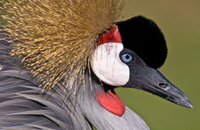A Plan To Secure the Future of Grey Crowned Cranes in Africa

Grey Crowned Cranes (Balearica regulorum), icons of Africa’s grasslands and wetlands, were once considered the most common of Africa’s cranes and in no way threatened. However, less than 45 years later, the species has declined by around 80% across its range, and is now the fastest declining of the world’s 15 crane species. As a result, the Grey Crowned Crane was recently uplisted to Endangered on the global IUCN Red Data List. Responding to this situation, the African-Eurasian Migratory Waterbird Agreement (AEWA) prioritised the Grey Crowned Crane for conservation action.
An AEWA Single Species Action Planning Workshop for the Conservation of the Grey Crowned Crane took place in Musanze, northern Rwanda from 10 - 13 September 2013. It was hosted by the Rwanda Environment Management Authority (REMA). The event was organised by the Endangered Wildlife Trust’s (EWT) African Crane Conservation Programme, in partnership with the International Crane Foundation, and was facilitated by the UNEP/AEWA Secretariat.
Found across 15 countries in Southern and East Africa, nine of the range countries (Burundi, the Democratic Republic of Congo, Kenya, Rwanda, Uganda, South Africa, the United Republic of Tanzania, Zambia and Zimbabwe) were represented at the workshop. Of the remaining six countries not represented (Angola, Botswana, Namibia, Malawi, Mozambique and South Sudan), Mozambique was the only one with a significant Grey Crowned Crane population. A total of 31 participants, representing government and the wider conservation community attended the four days of the workshop.
- the loss and degradation of suitable wetlands for nesting and the surrounding catchment for foraging, as a result of agriculture, drainage, Eucalyptus plantations, changes to hydrological regimes, infrastructure development, siltation and mining;
- the illegal trade in cranes for local and international captive trade markets;
- human disturbance primarily through wetland based agriculture and livestock herding;
- poisoning, in an attempt to reduce the damage that cranes can cause to agricultural crops; and
- collisions with overhead power lines and electrocutions on electrical infrastructure.
Representing EWT, Dr Harriet Davies-Mostert presented a very preliminary model of species population dynamics, based on twenty years of data for the only healthy and growing population, in South Africa. She showed clearly the impact that the percentage of adult pairs breeding, the number of offspring produced and adult mortality, had on the population and future predictions. Each of the threats outlined above significantly influence each of these factors and hence the plan focused initially around understanding the reasons for reduced breeding productivity and reproductive rates, reduced mortality or the loss of birds from the wild population, and the high degree and rate of habitat loss, fragmentation and degradation.
The visit of the workshop participants to Rugezi Marsh highlighted many of these threats and the real challenge ahead for future conservation efforts. The area's very high human population, high poverty levels and intensive and complete transformation of the catchment into subsistence agriculture, have put severe pressure on wetlands, with impacts compounded by the second major threat - capture of almost all crane chicks for sale to hotels and gardens within the country. This scenario, however, is playing itself out to a lesser or greater degree across Africa, with no indication of abating at this time.
With a clear understanding of the threats in everyone's minds, the remaining workshop time was spent mapping out possible solutions for the action plan and aligning responsibility and time frames. The action plan is currently being drafted and will be circulated widely for comment and revision before finally being presented for endorsement to the 6th Session of the Meeting of the Parties in 2015. It is only through a committed, multi-stakeholder and coordinated approach that the future of Grey Crowned Cranes in Africa will be assured. AEWA will also continue to support the implementation and evaluation stages of this ten-year process, with an inter-governmental working group guiding the effort.
We would like to thank the Swiss Federal Office for the Environment (FOEN), the Dohmen Family Foundation, The German Nature and Biodiversity Conservation Union - NABU and Cologne Zoo (Germany) for their financial support of this workshop. In addition, the proceeds raised by a charity concert performed in Bonn by the Bologna Opera Choir on the occasion of World Migratory Bird Day 2013 (WMBD) also contributed to the development of the ISSAP.
Dernière mise à jour le 20 January 2014


